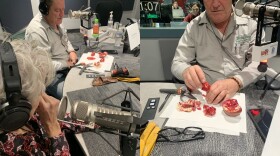Most of us don’t have big acreage for our gardens. That’s why we try to pack so much into them. Sometimes, though, we do get carried away, putting the least amount of space required between plants. That’s how usually I practice gardening.
Just when you’re certain you have no room to spare, nature finds that one unoccupied spot and fills it. Sometimes plants just appear in my garden, my wildly overplanted garden!
Usually, when a plant appears in a garden without our consent, we call it a weed. Yes, technically any plant in my garden that I didn’t plant could be called a weed. The plants I’m talking now about aren’t the weeds I pull out as soon as I find them – sow thistle, purslane, black medic – we’re mostly in agreement that these must be removed.
What I’m talking about are three surprises, desirable plants that arrived in my garden without any work on my part.
Last year, I planted tomatillos, and got huge crops of them. It wouldn’t be a shock if I’d found they were growing again in that same raised bed, but no, I now have one growing in the path next to a raised bed, in unamended soil.
Another’s now thriving in a large pot where I’ve had a grapefruit tree struggling for survival, clearly not a happy fruit tree, but a very happy tomatillo. A third one seems to be trying to take over another raised bed where they’ve never been planted. They’re producing flowers, but I have yet to see a single fruit.
Last year’s crop consisted of all purple tomatillos; I’m curious as to what color this year’s will be. If those purple ones were hybrids, they might not breed true in subsequent years. Should this year’s crop be all green, it wouldn’t be newsworthy.
All these tomatillo plants can easily be explained by birds dropping seeds from last year’s crop, and heaven knows I have birds. Very well fed, enthusiastic mockingbirds, finches, doves, and sparrows, among others.
The bougainvillea that’s now growing in a raised bed is a mystery. I’ve been following it for a while now, but I didn’t notice it as a seedling. As it was growing, I said to myself “the foliage is familiar, but what is it?”
I finally recognized the leaf shape, with a hint of red. The only creatures who’ve shown any interest in it are leaf cutter bees. They prefer it to my roses. Fortunately, I’ve always liked the scalloped edges that these bees leave on foliage.
I’m still waiting for flowers to arrive, and I might have to wait until next year, when I’ll also need to deal with the plant and its thorns. I can’t let it take over an entire raised bed, which it would gladly do. I hate transplanting anything large, but there are occasions when you have no choice.
A total shock was the pomegranate tree I noticed in a corner, far from the spot where I did have one growing for several years. That tree had become so large I could barely walk around my garden, so I removed it.
I know, that sounds monstrous, removing a perfectly happy, healthy tree for my own convenience! Don’t worry. It seems that I didn’t remove the entire root system and one part of it apparently sent out a robust new shoot. It’s not a seedling since it’s grown so much in a short period of time. This astonishing fruit tree is now five feet tall. While I’m tickled to have a new tree that’ll be productive, I wish it had taken over a slightly different spot. It’s elbowing its way through that corner, pushing aside a vigorous desert willow as well as a Sicilian bay laurel that’s finally getting some traction (been trying to get that one going for years). While I’d be happy to see it in another location, I don’t know how I could move it, especially if it’s growing from a root segment.
You may be thinking that if those were the biggest problems I had in my life, I’ve had a charmed life! I’m not grumbling about the appearance of new plants. If they’re willing to grow without my help, and ultimately give me flowers and fruits, of course I’m not complaining!
I’ve concluded that my garden is magic, and that’s fine with me.
For KNPR’s Desert Bloom, this is Dr. Angela O’Callaghan of the University of Nevada Extension.







